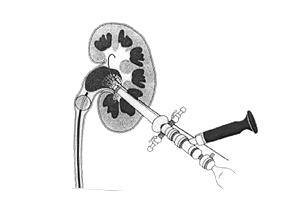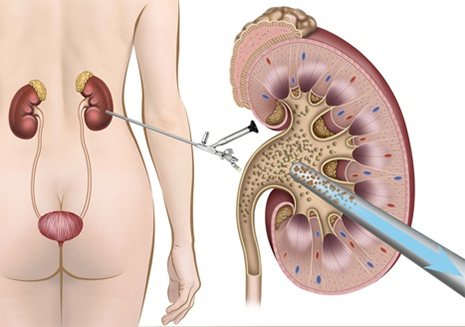
What is a Percutaneous Nephrolithotomy?
A Percutaneous Nephrolithotomy, also referred to as a PCNL, it a procedure used for treatment of large stones within the kidney. In this procedure a thin tube is placed into the kidney through the back, and a specially designed device is used to break up the stone and remove the pieces. In addition to a traditional PCNL, there are also mini-PCNL approaches now available for some stones than can improve success rates over other procedures with minimal burden on the patient.
Why might I need a Percutaneous Nephrolithotomy?
The most common reason for a PCNL to be performed is a large kidney stone, usually 1-2cm in size. The stones may be large, or in difficult locations to access using less invasive techniques, or there is a strong reason they should be removed in a few pieces as possible (such as persistent infection).
Percutaneous access can also be used to treat cancers of the collecting system of the kidney. While these are not PCNLs, they are performed in a very similar way.
Preparing for your Percutaneous Nephrolithotomy:
In general, preparation for a PCNL will involve the following steps:
- You will have bloodwork and other testing done at the hospital
- The hospital will call you to confirm arrival time and instructions
- You will be asked if you have allergies to medications, anesthesia, or latex.
- You should inform your doctor of any medications, vitamins, or supplements that you are taking.
- You should refrain from taking anti-inflammatories or blood-thinning medications a week prior to the procedure. Any blood thinning medications will be discussed with you and your doctors
- It is also important to inform your doctor if you are pregnant or might be pregnant, diabetic, asthmatic, or have any other medical conditions.
- You may be asked to refrain from eating 8 hours prior to your scheduled arrival time and drinking 2 hours prior to your arrival time.
- You should remove all metal objects and accessories such as eyeglasses, jewelry, watch, etc. as they can interfere with the imaging technique used.
- You should arrange for someone to drive you home after the procedure.
Some patients may be started on antibiotics prior to the procedure.
The day or morning prior to your PCNL you may undergo a procedure to have a nephrostomy tube placed. This tube is placed into your kidney through your back by an interventional radiologist and helps your surgeon to access your kidney. Not all patients will require this.

What happens during a Percutaneous Nephrolithotomy?
When you arrive at the hospital you will meet with an anesthesiologist who will explain how they will keep you asleep and comfortable during the surgery. General anesthesia is required for this surgery. Once in the operating room, you will go to sleep on a stretcher, then be transferred, face down, to the operating table.
Your surgeon will either use the nephrostomy tube placed by an interventional radiologist or use a combination of Xray and ureteroscopy (a camera placed into your bladder then up to your kidney) to access your kidney. They will place a tube that is slightly under half an inch thick into the kidney, near the stone.
A miniature jackhammer type device that also carries an ultrasonic projector will be used to break the stone into small pieces and remove it. Some stones can be removed without breaking. After all the pieces of your stone are removed, your surgeon will inspect your kidney and the ureter (the tube that drains the kidney) for any remaining pieces or signs of inflammation. You will then have some form of drainage tube placed, either a ureteral stent (a soft plastic tube that passes from the kidney to the bladder) or a nephrostomy (a soft plastic tube that passes from the kidney out the back), and a dressing will be placed.
You will wake up in the recovery room. A very small percentage of patients require a second procedure after their first. Many patients are able to go home the same day, but a significant percentage will remain in the hospital overnight for observation.
Post-Operative Instructions
Activity
You can resume normal activity 1 week after your procedure. If you have a nephrostomy or stent in place, wait at least 3 days after it is removed before you swim or sit in a tub bath.
Diet
Your surgeon will discuss dietary options for prevention of kidney stones in the future, but no specific diet is required after the surgery.
Bathing
You may bath normally 48 hours after the procedure. If you have a nephrostomy in place you may have to remove your dressing before, but most patients can remove their dressings in 48 hours.
What can I expect after my Percutaneous Nephrolithotomy?
It is normal to have pain in your back and some blood in your urine after the procedure. If you have a ureteral stent, expect some urinary urgency and discomfort with urination until it is removed.
Most patients feel completely normal within 1 month of their procedure.
What are the risks of a Percutaneous Nephrolithotomy?
During the procedure there is a risk of excessive bleeding requiring transfusion, absorption of excess fluid limiting the length of the surgery, failure to access the kidney requiring a second attempt surgery at a different time, and injury to any localized structures. All stones are typically removed, but your surgeon can discuss the specific odds of complete success for your stones with you.
Less common adverse events include infection, formation of a local blood clot (called a hematoma), injury to bowel, abscess formation, and injury to the kidney causing decrease in kidney function.
There is an extremely small risk of a urinary fistula, in which a persistent connection between your back and the skin is created.
